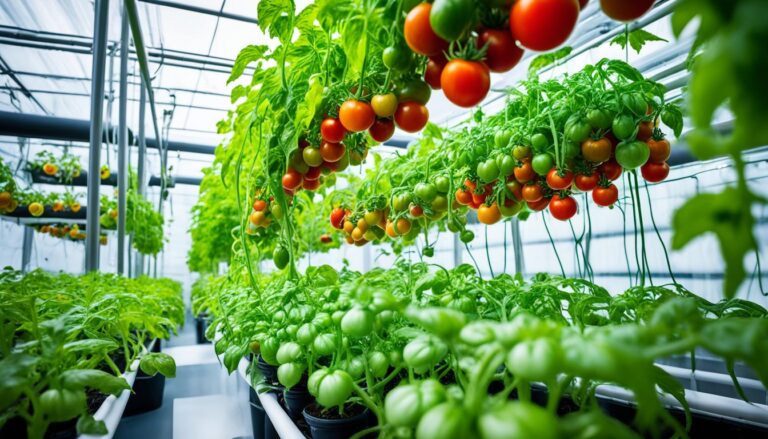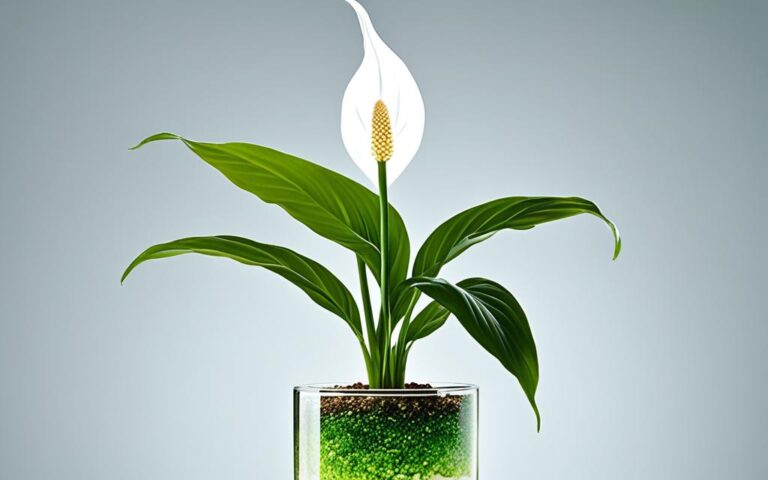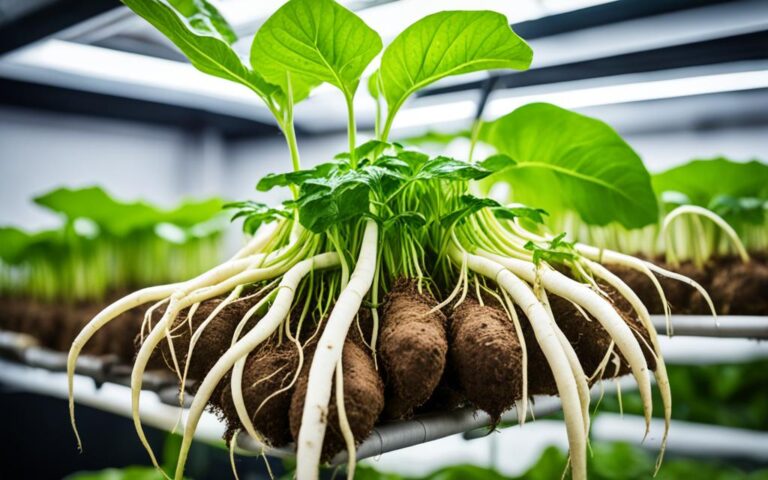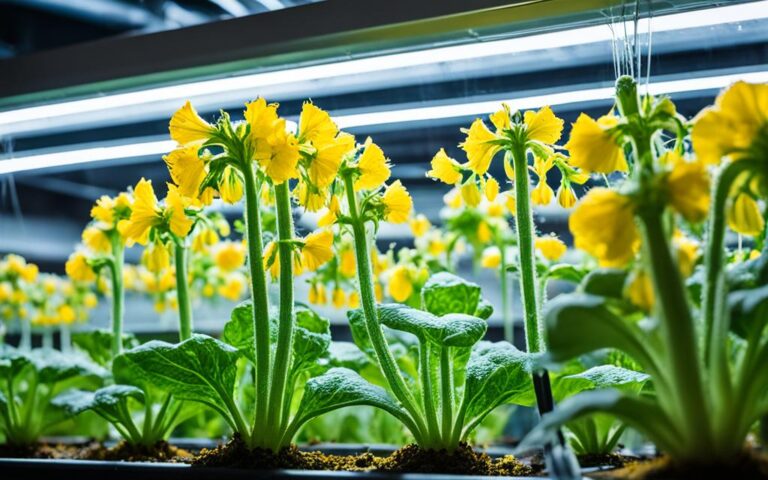Grow Vibrant Hydroponic Chard at Home Easily
Did you know that one cup of raw Swiss chard has over 700% of your daily Vitamin K? This leafy green is packed with vitamins, minerals, and antioxidants. It’s a great addition to a healthy diet. Plus, hydroponic chard is easy to grow at home, so you can enjoy it all year.
Hydroponic chard gardening is a simple way to grow this nutritious vegetable. It’s perfect for small indoor spaces or larger outdoor areas. This guide will show you how to grow hydroponic chard and get a big harvest of this versatile leafy green.
Key Takeaways
- Hydroponic chard is a nutrient-dense, colorful, and easy-to-grow leafy green
- It can be cultivated indoors or outdoors using a variety of hydroponic systems
- Hydroponic chard has moderate light and temperature requirements and a wide nutrient range
- Proper seed selection, transplanting, and maintenance are key to a successful hydroponic chard harvest
- Hydroponic chard is an excellent source of vitamins, minerals, and antioxidants
Introduction to Hydroponic Chard Gardening
Swiss chard is a vibrant, nutritious leafy green from the beet family. It’s easy to grow using hydroponic methods. Hydroponics grows plants without soil, using nutrient-rich water and a special medium instead. This way, you can enjoy hydroponic chard all year, get more produce, and save water and space.
Hydroponic chard hydroponics is a new, green way to garden that’s getting popular. It lets you control the plant’s environment for better growth. This method makes growing chard hydroponically easy and rewarding, leading to a big harvest. We’ll cover the basics of hydroponic chard gardening here, preparing you for more details on benefits, types, and how to grow your own at home.
“Hydroponic gardening is the future of sustainable food production, and chard is a perfect candidate for this innovative approach.”
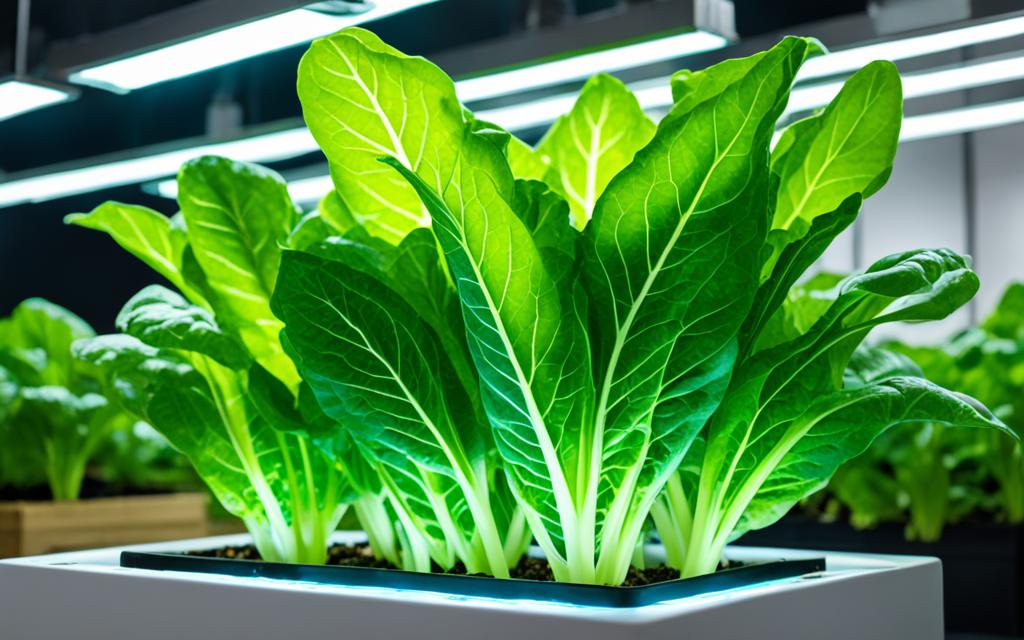
We’ll look at why hydroponic chard is great, the best varieties for hydroponics, and how to set up and care for your garden. This guide is for both experienced gardeners and beginners wanting to try hydroponics. You’ll learn everything you need to grow your own healthy, tasty hydroponic chard at home.
Benefits of Growing Hydroponic Chard
Hydroponic chard is easy to grow at home and has many benefits. It’s a leafy green that’s full of nutrients and looks great. It’s perfect for both indoor and outdoor gardens.
Nutrient-Dense Leafy Green
Chard grown in hydroponics is full of vitamins and minerals. It’s a great source of vitamins A, C, and K, and minerals like magnesium and potassium. It also has antioxidants like beta-carotene, which is good for your health.
Colorful and Ornamental Varieties
Hydroponic chard comes in many bright colors, like red, yellow, and rainbow. These plants add beauty to any garden, indoors or outdoors. They’re chosen for their looks and taste.
Adding hydroponic chard to your diet or garden is rewarding. It’s full of nutrients and looks beautiful. It’s a great choice for anyone who loves to grow their own food.
Popular Varieties for Hydroponic Systems
Growing hydroponic chard is exciting, with many popular varieties that do well without soil. These best chard varieties for hydroponics come in different colors, textures, and tastes. They make your hydroponic garden more vibrant.
Fordhook Giant
Fordhook Giant is a top choice for its big, dark green leaves and white stems. It’s loved for its size and strong taste. This makes it a great pick for growing in hydroponics.
Bright Lights
Bright Lights chard stands out with its colorful stems in red, yellow, pink, and orange. It’s not just pretty; it also tastes unique. This makes it a great choice for hydroponic gardens.
Rainbow
The Rainbow chard variety has stems in many colors, from deep red to yellow. It’s a treat for the eyes and full of vitamins and minerals. This makes it a healthy addition to your hydroponic garden.
Lucullus
Lucullus chard is known for its soft, mild taste and delicate leaves. Its light green leaves and white stems look great in hydroponic setups. It’s also easy to use in cooking, making it a favorite among gardeners.
These four chard types, Fordhook Giant, Bright Lights, Rainbow, and Lucullus, are perfect for hydroponics. They offer a mix of colors, textures, and flavors for your home-grown chard garden.
Hydroponic Chard Growing Requirements
To grow vibrant hydroponic chard, you need to know its light, temperature, and nutrient needs. By giving it the best growing conditions, you can make sure it stays healthy and productive. This leafy green is versatile and easy to grow.
Light Needs
Hydroponic chard loves full sun and needs at least 6 hours of direct sunlight daily. But, it can also grow well in partial shade. This makes it a great choice for indoor or partly shaded setups. Getting the hydroponic chard light requirements right is important for its growth and taste.
Temperature Preferences
The best temperature for hydroponic chard is between 50°F and 75°F. It can also handle cooler temperatures down to 20°F, but too much cold can affect its health and yield. Keeping a steady hydroponic chard temperature is crucial for its growth.
Water and Nutrient Considerations
- Keeping the soil consistently moist is key for healthy chard growth.
- A balanced nutrient solution with an EC of 1.8-2.3 and a pH of 5.5-6.8 is best for hydroponic chard nutrients.
- Checking and adjusting the nutrient and pH levels regularly ensures the plants get what they need.
By meeting the specific needs of hydroponic chard for light, temperature, and nutrients, gardeners can enjoy a plentiful harvest of this nutritious and beautiful leafy green.
Setting Up a Hydroponic System for Chard
To grow vibrant chard with a hydroponic system, you need to put together several important parts. The system starts with a fish tank or reservoir that has nutrient-rich water. This water then moves to the grow bed where the chard plants grow well.
The grow bed can be made in different ways, like a media-based system, a nutrient film technique (NFT) system, or a raft system. Each type has its own benefits and needs specific setup and care. This ensures the best growing conditions for chard in a hydroponic setup.
Choosing the Right Grow Bed
- Media-based systems use a growing medium like perlite or coco coir to support the chard plants and keep their roots stable.
- NFT systems have a continuous flow of nutrient-rich water over the plant roots, helping them absorb nutrients well.
- Raft systems let the chard plants float on a buoyant platform in the nutrient-rich water.
No matter the grow bed you pick, setting up and maintaining the hydroponic system is key. It helps create the perfect conditions for growing hydroponic chard.
| Grow Bed Type | Key Considerations | Advantages |
|---|---|---|
| Media-based | Choosing the right growing medium, ensuring adequate aeration and drainage | Provides a stable root environment, supports a wide range of plant types |
| NFT | Maintaining a consistent water flow, monitoring nutrient levels | Efficient nutrient delivery, compact design, easy to scale |
| Raft | Selecting a suitable floating platform, managing water depth and oxygenation | Simplicity of design, ease of plant management, visual appeal |
By picking and setting up the right hydroponic system for chard, home gardeners can grow a healthy, nutrient-rich crop in their own spaces.
Choosing the Right Hydroponic System
Choosing the right hydroponic system is key to growing healthy, nutrient-rich chard. Gardeners have many options, each with its own benefits for growing top-notch hydroponic chard.
Media Bed Systems
Media bed systems use a medium like expanded clay or gravel for the chard’s roots. This method ensures steady nutrient supply, making it great for growing hydroponic chard. The medium keeps moisture levels right, preventing waterlogging and helping plants grow well.
Nutrient Film Technique (NFT)
The Nutrient Film Technique (NFT) is a favorite for growing hydroponic chard. It uses a thin film of nutrient-rich water that flows over the roots. This system gives chard the nutrients it needs without overwatering.
Raft Systems
Raft systems float chard plants with their roots in the water. This setup gives roots direct access to nutrients, promoting strong growth and lots of chard.
When picking the best hydroponic system for your chard, think about your setup’s needs. Consider space, water use, and nutrient control to find the best system for growing healthy, hydroponic chard.
Selecting a Suitable Location
Choosing the right spot for your hydroponic chard is key to growing it well at home. You want an area that gives your chard the best chance to flourish. Let’s look at what makes a spot perfect for location for hydroponic chard.
Your hydroponic chard setup location needs at least 6 hours of sunlight a day. If it doesn’t get enough sun, you might need grow lights to help it grow.
- It’s also crucial to have easy access to water and electricity. Your hydroponic system will need power for pumps and air.
- Keeping your chard safe from harsh weather is important. Using a greenhouse or shade cloth can help.
- Make sure you have enough space and can easily get to your system for upkeep and checks.
By picking the right location for hydroponic chard, you set up a great place for these healthy, colorful leaves to grow. This way, you can enjoy a lot of fresh chard right at home.
“Creating the perfect growing environment is the first step to successful hydroponic chard cultivation.”
Fish Selection for Aquaponics
When adding an aquaponic system to your hydroponic chard, picking the right fish is key. Tilapia are a top pick because they’re tough, grow fast, and do well in various water conditions. Goldfish and koi are good for smaller or decorative systems.
Think about the fish’s water temperature likes, how big the tank needs to be, and if you plan to eat them. A well-sized tank and good water quality are crucial for a healthy aquaponic setup. This supports your aquaponics chard system.
- Tilapia: Hardier, faster-growing fish that adapt well to a range of water conditions.
- Goldfish: Suitable for smaller or ornamental aquaponic systems.
- Koi: Another option for decorative or smaller-scale aquaponic setups.
“Choosing the right fish is crucial for a successful aquaponic system that supports vibrant hydroponic chard growth.”
It’s vital to keep the water quality and tank size right for your chosen fish. This ensures a balanced aquaponic environment. It helps your hydroponic chard grow well.
Starting Hydroponic Chard from Seeds
Growing vibrant hydroponic chard begins with the right seeds. Choose high-quality seeds from a trusted supplier. Pick chard varieties that fit your climate and growing conditions for the best results.
Seed Selection and Germination
Chard seeds germinate in 7-14 days in a warm, bright spot with steady moisture. To start, sow the seeds in a clean, soilless medium and keep it moist. Watch the seedlings closely, making sure they get enough light for strong growth.
Transplanting Seedlings
When the chard seedlings have a few true leaves, it’s time to move them to the hydroponic bed. Carefully take the seedlings out of the medium without harming their roots. Slowly get them used to the hydroponic system’s conditions over a few days. Make sure they have enough space to grow well.
By following these steps, you can grow a healthy crop of hydroponic chard at home. With the right seeds and careful transplanting, your chard will get off to a great start.
Planting and Spacing Requirements
When growing hydroponic chard, getting the hydroponic chard planting and spacing right is key. In a hydroponic setup, keep chard plants 6-12 inches apart. This gives each plant enough room for its roots to grow well without crowding.
For hydroponic chard spacing in a Nutrient Film Technique (NFT) system, make sure the channels are wide enough. They should fit the mature root system of the chard, keeping plants 6-12 inches apart. This spacing helps with airflow, light, and getting nutrients to the plants, making them healthier.
- Space chard plants 6-12 inches apart in hydroponic grow beds
- Ensure NFT channels are wide enough to allow 6-12 inch spacing for chard roots
- Proper spacing enhances airflow, light, and nutrient access for the plants
“Correctly spacing chard plants in a hydroponic system is crucial for their growth and development.”
hydroponic Chard Maintenance
Keeping a hydroponic chard garden healthy means paying close attention to nutrients and pH levels. Swiss chard loves a balanced nutrient mix. It does best with an electrical conductivity (EC) of 1.8-2.3. Sometimes, it can even do well with an EC as low as 0.8.
Nutrient Management
It’s important to check and tweak the nutrient levels in the water often. This makes sure the hydroponic chard gets all the nutrients it needs to grow big and strong. A balanced mix of nutrients makes for healthy, colorful leaves.
pH Monitoring
Keeping the water’s pH right is also key. It should be between 5.5-6.8. This lets the hydroponic chard take in nutrients easily, making the chard taste great.
Testing and adjusting the hydroponic chard pH regularly is a must. It helps your plants grow well and take in nutrients properly.
“Proper nutrient management and pH control are the keys to growing thriving hydroponic chard at home.”
Harvesting and Storage Tips
Growing vibrant hydroponic chard at home is rewarding. It’s important to know how to harvest and store it right. This way, you can enjoy your fresh produce for a long time. Let’s look at the best ways to harvest hydroponic chard and keep it fresh.
To harvest hydroponic chard, pick the mature outer leaves. This lets the younger leaves inside keep growing. This method means you can keep getting fresh chard for a while. Make sure to leave about 30% of the leaves on the plant to help it keep growing.
For the best taste and quality, pick chard in the morning or evening. These are the best times when the plant is full of water. After picking, put the leaves in containers or bags without washing them. Keep them cool to make them last over a week. If you have more chard, you can freeze it, but it might change a bit.
| Harvesting Tips | Storage Tips |
|---|---|
|
|
By using these hydroponic chard harvest and hydroponic chard storage tips, your homegrown chard will stay fresh and tasty. These methods will make your hydroponic chard gardening even better and more fun.
Common Pests and Diseases
Hydroponic chard is usually tough and healthy. But, it can face pests and diseases. Knowing about these issues and dealing with them quickly is key to keeping your hydroponic chard plants strong.
Aphids are a big problem for hydroponic chard. These tiny insects suck sap from the plants. They can form large groups on leaves and stems, hurting the plant’s health and how it gets nutrients. It’s important to watch for aphids and use organic ways to control them.
Powdery mildew is another disease hydroponic chard can get. It looks like white powder on the leaves. If not treated, it can stop the plant from making food. Keeping the right temperature, humidity, and air flow can help stop powdery mildew.
Preventing and Managing Pests and Diseases
- Regularly check your hydroponic chard for pests and diseases.
- Use organic pest control, like introducing helpful insects or natural pesticides, to fight pests.
- Keep the environment right, with good air flow, the right humidity, and balanced nutrients, to stop diseases.
- Quickly remove and throw away any sick plants to stop infections from spreading.
By being careful and acting fast, you can keep your hydroponic chard healthy and full of life. This ensures a big and tasty harvest.
Troubleshooting Hydroponic Chard Issues
Hydroponic chard is usually easy to grow, but sometimes you might face challenges. By watching your hydroponic system and the chard closely, you can spot and fix problems fast.
Nutrient deficiencies are a common issue with hydroponic chard. This can show up as slow growth, leaves that look off-color, or other signs of not getting enough nutrients. Keep an eye on your nutrient solution levels and adjust them if needed to make sure your chard gets what it needs.
Another issue is pH imbalance. Chard likes a slightly acidic pH, between 6.0 and 6.8. If the pH gets too far off, it can stop the plants from taking in nutrients properly. Test the pH often and adjust it to stay in the right range.
- Check and fix nutrient levels to prevent shortages
- Keep the pH between 6.0 and 6.8 for healthy plants
- Make sure the water quality is good and the flow is steady
- Watch out for and fix any stress from extreme temperatures
By taking care of these common problems, you can fix any issues with your hydroponic chard. This will help keep your plants healthy and productive.
Conclusion
Growing hydroponic chard at home is rewarding and easy for anyone. It’s great for both experienced gardeners and beginners. This leafy green is packed with nutrients and looks great in many hydroponic setups.
To make sure your hydroponic chard grows well, you need the right light, temperature, and nutrients. Keeping up with maintenance is also key. This way, you can enjoy a steady supply of fresh hydroponic chard all year.
Hydroponic chard is not just good for you, but it’s also super versatile in the kitchen. You can grow different types like Fordhook Giant, Bright Lights, and Rainbow. This lets you have a colorful and tasty variety of greens.
Adding hydroponic chard to your garden, indoor or outdoor, means you’re growing your own food sustainably. It also makes your cooking more exciting. With the right knowledge and care, you can easily grow beautiful hydroponic chard. This makes your gardening journey both fun and rewarding.

